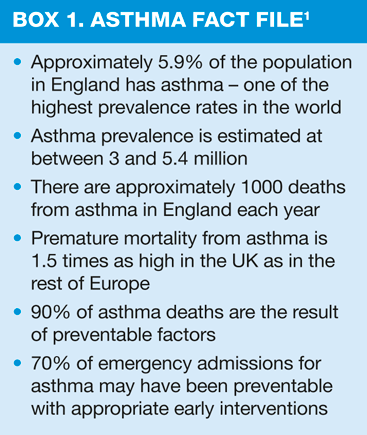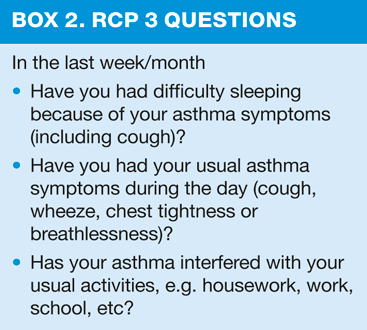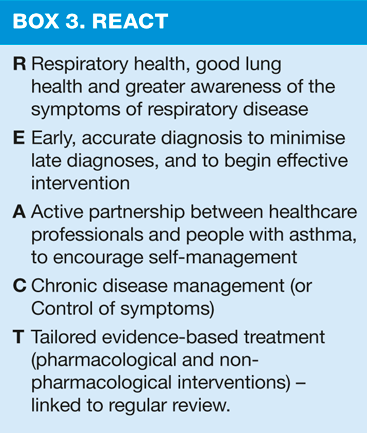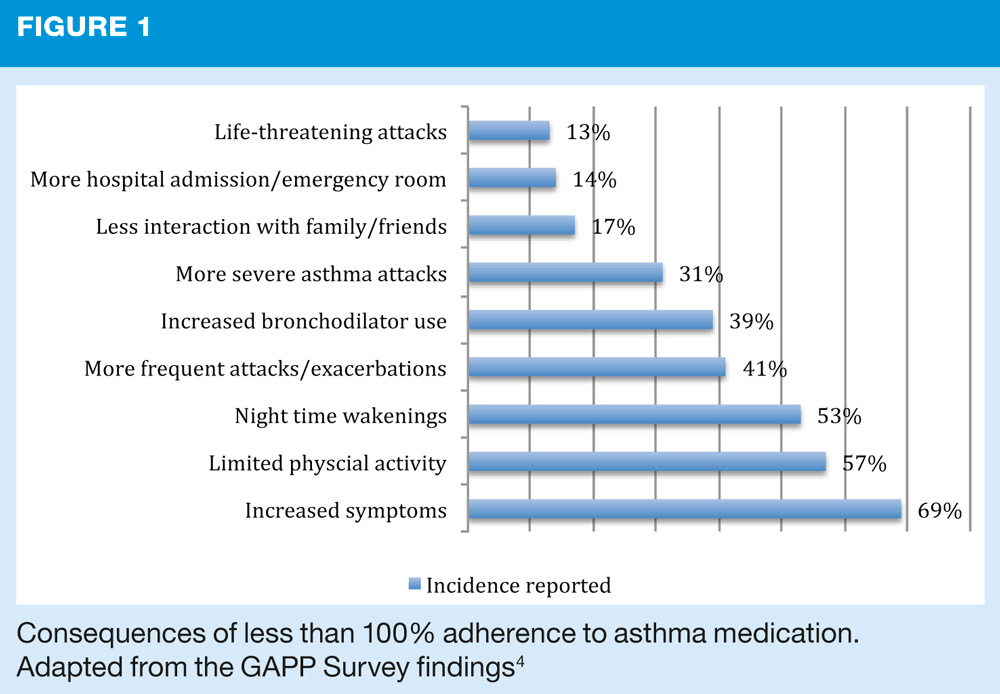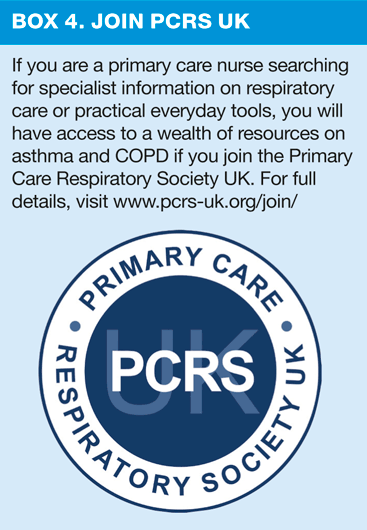
Improving long-term outcomes in asthma
Mandy Galloway
Mandy Galloway
Medical writer
Editor, Practice Nurse
With so much attention focused on COPD in recent years, it is easy to overlook the fact that asthma also poses a significant burden both on individuals and on the NHS, and there is still scope to improve outcomes
Like COPD, asthma is a common long-term respiratory condition. Classic symptoms include breathlessness, tightness in the chest, coughing and wheezing. Unlike COPD, asthma is not a condition involving a gradual deterioration over time, and its causes are not well understood, so prevention is not currently possible.1
Although the UK has been a world-leader in developing guidelines for asthma, they have not been uniformly adopted, and there is considerable variation in outcomes, with a five-fold difference between PCT areas in the number of emergency admissions for adults. The number of asthma deaths has also plateaued, at around 1000 - 1200 per year, and appears not to have reduced since 2000. Whereas COPD is predominantly a disease of older people (45-years-plus), asthma affects people of all ages, and deaths occur throughout the age range.1
The impact of asthma on individuals is also significant, and according to the Department of Health's Outcomes Strategy for COPD and Asthma in England, many patients report that their asthma is poorly controlled, and is affecting their ability to undertake the normal activities of daily living.1
The aim of asthma management is to control the disease.2 Complete control is defined as:
- no daytime symptoms
- no night time awakening due to asthma
- no need for rescue medication
- not exacerbations
- no limitations on activity, including exercise
- normal lung function (FEV1 and/or PEF >80% predicted or best)
- minimal side effects from medication
OPTIMAL CONTROL
The Primary Care Respiratory Society (PCRS) has useful guidance on optimising asthma control, which starts with the assessment of current level of clinical control, as well as an assessment of the individual's risk of future problems, such as exacerbations, rapid decline in lung function or side effects of treatment.3
In addition to asking the RCP 3 questions (Box 2), other useful questions for assessing control include:
- How many days per week do you have asthma symptoms?
- Do you ever wake at night due to asthma?
- How often do you use your reliever medication?
- Can you walk up a flight of stairs without stopping?
- What bothers you most about your asthma?
Recording the answers to these questions provides a useful benchmark for comparison at the next visit.3 Clinical control should be assessed at each visit, to allow identification of improvement or deterioration, which in turn, points to the need to step up or step down treatment as defined in the BTS/SIGN Asthma Guideline.2
While 'optimal' means best possible asthma control, healthcare professionals often use the term to mean 'total' control - a state that only a minority of patients will be able to attain.3 Patients also appear to have a poor perception of their asthma, with marked discrepancies between their assessment of disease severity, and that of healthcare professionals.4 Similarly, patients' awareness of the side effects of medication tends to be overestimated by healthcare professionals, but at the same time, patients' concerns about side effects tend to be underestimated.4
These discrepancies are important because patients may perceive the risks of asthma to be insignificant, but the risks of corticosteroid therapy to be substantial.3 This can affect their adherence to treatment. The Global Asthma Physician and Patient (GAPP) Survey found that patients switched or discontinued medication either because they thought their symptoms had improved (45%) or because of side effects (21%) or fear of side effects (18%). Almost half, 48%, claimed that they took their asthma medication as instructed 100% of the time - but only 5% of physicians thought patients were fully compliant.4
If patients underestimate the seriousness of their asthma, and do not take the medication as prescribed, their asthma control is likely to be sub-optimal, increasing their risk of poor outcomes. For example, regular use of bronchodilators without any inhaled steroid treatment can mask underlying airways inflammation, which could precipitate an exacerbation.
The consequences of non-adherence to prescribed medications are illustrated in Figure 1.
ENVIRONMENTAL FACTORS
There is a perception among patients that there are many environmental, dietary and other triggers of asthma, and that avoiding them will improve asthma.2 But the evidence for non-pharmacological management strategies is scarce and inconclusive.
For example, there is no consistent evidence of benefit from avoiding domestic aeroallergens, or for taking dietary supplements such as fish oils. Measures to decrease house mites, for example, decrease the number of house mites but do not have an effect on asthma severity.2
However, there is evidence that breast feeding has a protective effect in relation to early asthma, and there is an association between maternal smoking and increased risk of wheeze in their babies - two further valuable reasons for encouraging women to breast feed their babies and to stop smoking.2
There is also a link between increasing BMI and symptoms of asthma, so weight loss should be encouraged to promote general health and improve asthma control.2
ASTHMA IN ADOLESCENTS
The variability by PCT area of emergency admission for asthma in adolescents is even greater than that for adults, with a six-fold difference in admissions between different PCTs for patients under the age of 18.1 The BTS/SIGN Asthma guideline was updated in 2011 to give specific advice on the management of adolescents, in whom asthma is common but frequently undiagnosed because of under-reporting of symptoms.4
In fact, symptoms and signs of asthma in adolescents are no different from those in other age groups, but consideration needs to be given to some factors which are particular to young people, for example:
- Exercise-related wheezing and breathlessness are common in young people, but only a minority show objective evidence of exercised-induced bronchospasm.
- Other possible causes of breathlessness, such as hyperventilation or poor fitness, can usually be identified by careful clinical assessment.
- Tests of airflow obstruction and responsiveness may support a diagnosis of asthma, but are not always helpful as most adolescents have normal lung function
- Major depression, panic attacks and anxiety disorders are more common in adolescents with asthma and make asthma symptoms more prominent.
- Use of complementary and alternative medicine (CAM) in adolescents is widespread and may be a marker for non-adherence to prescribed medication.
- When asked, adolescents will admit that their adherence with asthma treatment and trigger avoidance (dust, fumes, spray, exertion and temperature changes) is often poor.4
WHAT IS BEING DONE TO
IMPROVE ASTHMA CARE
The Department of Health has been working with multidisciplinary groups, including nurses, GPs, hospital doctors, the voluntary sector and people with asthma, to look at ways of improving asthma care. The Asthma Steering Group has developed a good practice guide to provide commissioners with a description of the type of services that they should be making available to help patients achieve freedom from symptoms.
A review of the circumstances surrounding asthma deaths is also being undertaken by the Royal College of Physicians. It is not clear why the number of deaths has not reduced from around 1000 a year for many years, even though it is accepted that there are preventable factors in about 90% of these. The National Review of Asthma Deaths will take place in 2012-2013, to conduct a systematic investigation of asthma deaths, to include the medical care received as well as environmental conditions and the involvement of workplace and school. The review will try to identify how life-threatening situations arise, and how they can be avoided in future.
In addition, NHS Improvement is looking at ways of improving specific points of asthma care, such as training pharmacists to provide support to people with asthma about understanding and using their medication.
NICE is also considering new indicators for asthma for inclusion in the 2012/14 Quality and Outcomes Framework. One of these will be more specific about the content of the asthma review, to include an assessment of asthma control using the RCP 3 questions. (Box 2)
The Outcomes Strategy for COPD and Asthma signals a 'call to action' to healthcare professionals, the NHS as a whole and the public, including patients with respiratory disease to adopt the principles defined by the REACT acronym (Box 3), an approach that has already been proved to be successful for stroke.
CONCLUSION
The range of severity in asthma is considerable, and the degree of control of asthma symptoms may not be optimal.
Assessing asthma patients to check how well their asthma is controlled is a vital step in optimising control, ensuring that therapy is appropriate for the individual's disease status, and in reducing the risk of adverse outcomes including exacerbations and emergency admissions. Stratifying risk for a GP practice population is a bigger exercise, but can help practices to support people most in need of care.
REFERENCES
1. Department of Health. An outcomes strategy for COPD and Asthma in England. July 2011. www.dh.gov.uk/publications
2. British Thoracic Society/Scottish Intercollegiate Guidelines Network. British Guideline on the Management of Asthma. Revised May 2011. www.brit-thoracic.org.uk/guidelines/asthma-guidelines.aspx
3. Primary Care Respiratory Society UK. Optimal asthma control. Opinion No 46, November 2011. www.pcrs-uk.org
4. Canonica GW et al. Unmet needs in asthma: Global Asthma Physician and Patient (GAPP) survey: global adult findings, Allergy 2007;62:668-674
Related articles
View all Articles
